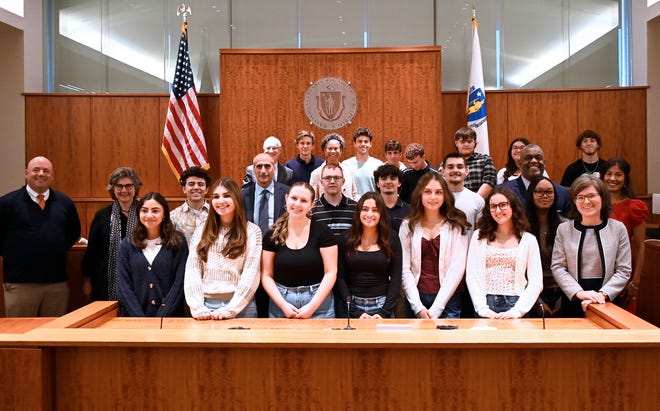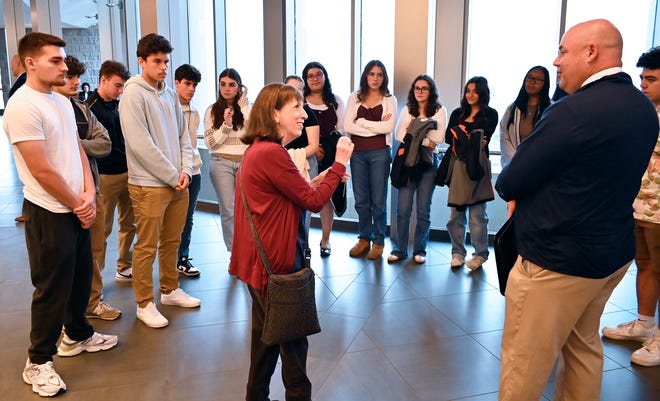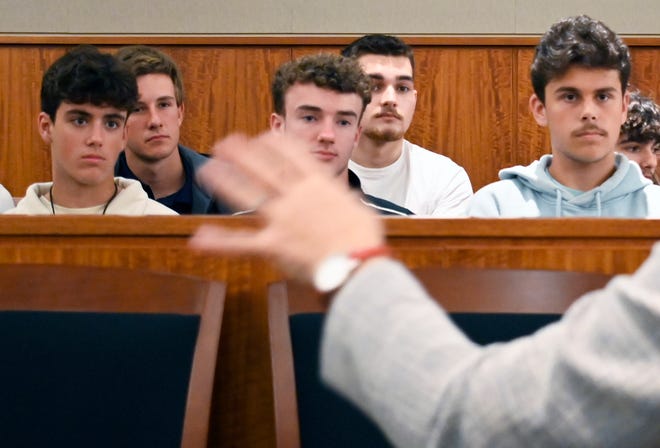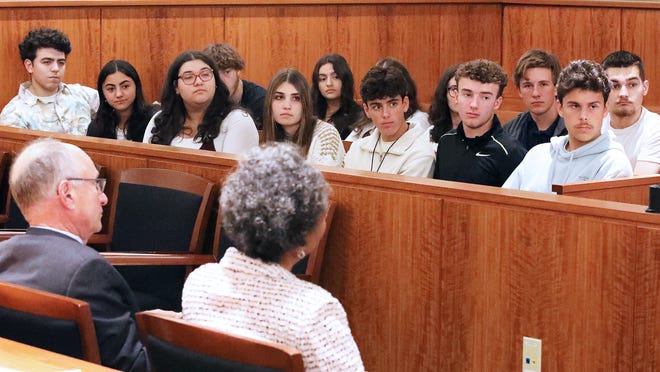Friends of Vocational Technical & Agricultural Education,
We are excited to share this piece, published by the “The Herald News”.
David
Diman students have Q&A with Supreme Judicial Court justices on Fall River field trip
Frank Mulligan The Herald News
FALL RIVER — After a full morning of weighing legal arguments, the Mass. Supreme Judicial Court’s seven justices returned to court to field questions from Diman Regional Vocational students.
The SJC session was held in Fall River Superior Court Oct. 8 instead of the John Adams Courthouse in Boston as part of an effort to familiarize the public with the court system, including the state’s highest appellate court.
Toward that same goal, the seniors and juniors in Tom Librera’s AP U.S. Government class at Diman observed the proceedings from the gallery and followed up with the Q&A session.
 The justices, led by Chief Justice Kimberly S. Budd, returned to the cleared courtroom in their street clothes, and sat across from the students, eye to eye, rather than looking down on them from elevated benches.
The justices, led by Chief Justice Kimberly S. Budd, returned to the cleared courtroom in their street clothes, and sat across from the students, eye to eye, rather than looking down on them from elevated benches.
Maybe it was their civilian attire that led to one of the students’ lighter questions – which the justices clearly enjoyed: “Do you like wearing robes?”
Associate Justice Serge Georges Jr.’s opinion was delivered decisively: “No.”
He has clung to his old “ratty” judicial robes for years, Georges admitted.
Associate Justice Gabrielle R. Wolohojian had a dissenting opinion. “Yes, they cover a multitude of sins,” she joked.
 Librera, who heads Diman’s Social Studies Dept., said the session was a “great opportunity for our kids to see the judicial system in action.” Some of the students were considering law school, he said.
Librera, who heads Diman’s Social Studies Dept., said the session was a “great opportunity for our kids to see the judicial system in action.” Some of the students were considering law school, he said.
The students heard oral arguments in three appeals cases before the SJC, all involving traffic stops that led to arrests for drugs and/or firearms. Were the arrests legally justified or did police overstep their bounds?
Associate Justice Elizabeth N. Dewar told the students it was unusual for the SJC to hear three cases in a row involving similar issues.
One of the allures of being a litigator and a judge, she said in reply to a student question, was the variety of topics that come before you. Learning about different worlds “is really fun.”
The class will be following up on what they experienced
Librera said the class would be following up with a discussion of the cases, and the constitutional issues raised. “It will give us a lot of great material for the kids to look at. It’s all very relevant to what we’re studying in AP Government.”
Asked what led her to law, Associate Justice Dalila Argaez Wendlandt – who has a master’s degree in mechanical engineering from MIT – said it motivated her. She liked debate in high school and liked helping people, including her parents where English was their second language.
 “I took the slowest route,” Wolohojian said, and pursued other studies until she entered law school in her late 20s. “I don’t think there’s a rush.”
“I took the slowest route,” Wolohojian said, and pursued other studies until she entered law school in her late 20s. “I don’t think there’s a rush.”
It wasn’t a big dramatic moment for Budd, she said. “My dad was a lawyer,” and that was enough.
She added, “When I was in your position, I had no idea I would be chief justice of the Supreme Judicial Court sitting before you today.”
You’ve got to really want it
Associate Justice Scott L. Kafker said it wasn’t necessary to start studying law at 15. “I studied history in college.”
He added that it’s important to really want to do it, though. There’s a lot of work and expense involved.
Asked whether they disagreed on issues, Wolohojian said, “all the time.”
But that’s part of the job, she said, as is “listening to what your colleagues are saying.” Disputes then tend to get resolved.
“It’s really hard to maintain an incorrect position when six other really smart people” disagree.
“We tend to work out our differences,” Kafker said.
Dewar said they discuss all their draft decisions at monthly meetings. “We give each other feedback,” which improves the final product. “The meetings are so helpful.”
U.S. Supreme Court didn’t have monthly meetings
The U.S. Supreme Court didn’t have monthly meetings when she served as a law clerk there, she said.
The Diman students included Kyran Aguiar, Draysen Almeida, Emersyn Boucher, Jacob Branco, Madeleine Cabral, Benjamin Courville, Nathan Franco, Alyssa Gendreau, William Goff, Adriana Machado, Francisca Martins, Madison Medeiros, Brody Mello, Evan Nickelson, Katreeya Noun, Kate Pontes, Joleah Rivera, Mason Vasconcellos, and Andrew Librera.
Chapter 74 Vocational Technical & Agricultural Education
LEARNING THAT WORKS FOR MASSACHUSETTS
David J. Ferreira
MAVA Communications Coordinator
DavidFerreira




